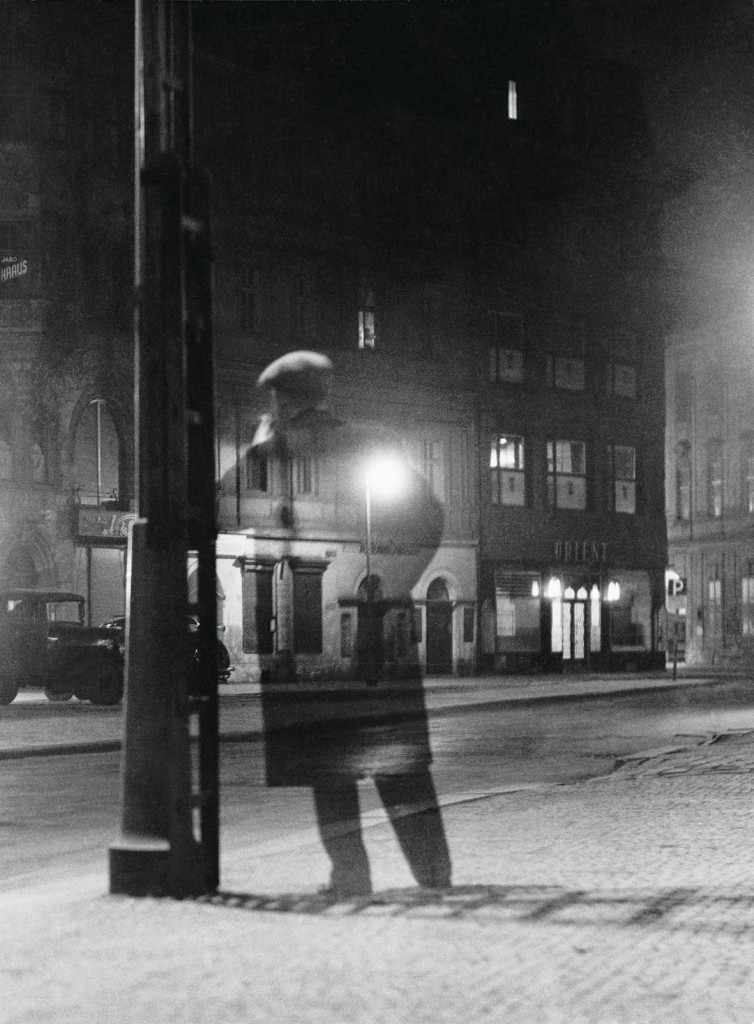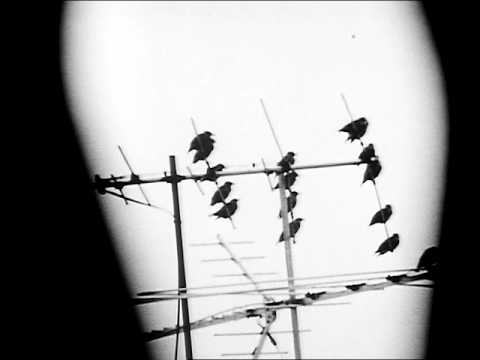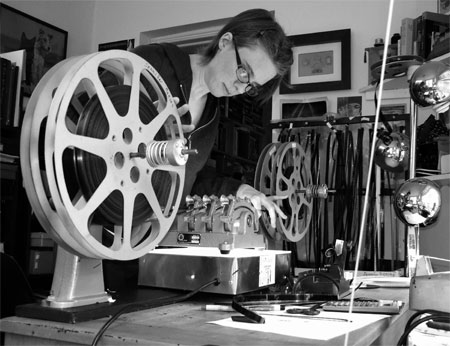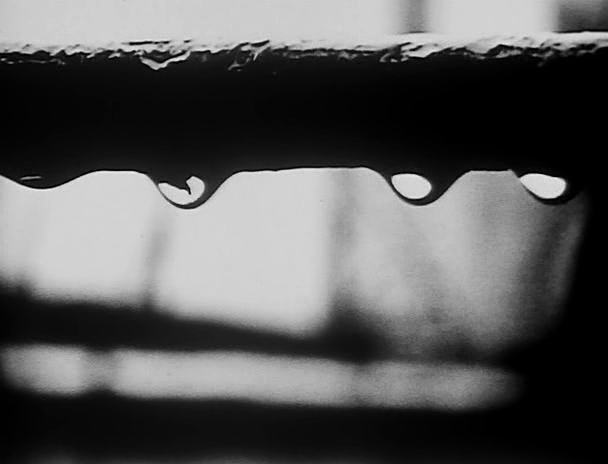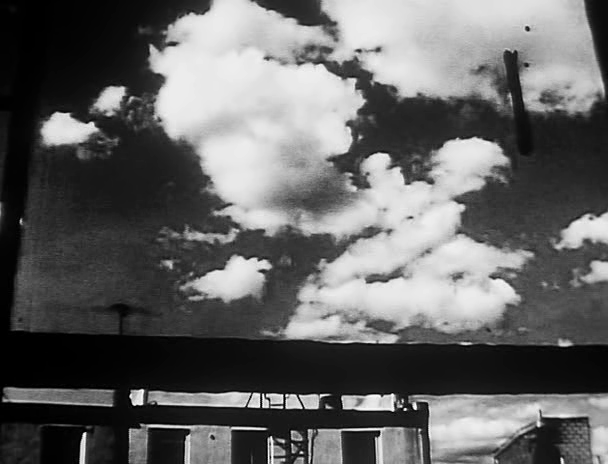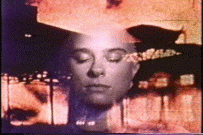
Jennifer Reeves at Cinematheque Ontario, Fall 2004
Susan Oxtoby: The Time We Killed premiered at the Berlin International Film Festival where it received the FIPRESCI award for best feature, and then picked up an award at the Tribeca Festival in May of this year for best New York narrative film. I want to welcome Jennifer to introduce the film and then of course she’s here with us to take questions afterwards. Please give a warm welcome to Jennifer Reeves.
Jennifer Reeves: Thanks for coming, I’m so glad to be here. I was struggling a little about how to introduce the film today because it evokes certain feelings that I had last Wednesday when Bush won another term as president. I still feel rather raw and depressed. So I prefer not to say a lot up front. I’ll just say this is quite a different feature film than you’re used to. We spend a lot of time in the head of a character that is somewhat of a split for me; it’s shot like a diary in my own apartment, but is presented as a narrative. I’ll be happy to answer any questions you might have about it.
Film screens.
Susan Oxtoby: Jennifer thank you so much for a very beautiful and interesting work. It’s hard to come up with questions after such an emotional experience as this, but I was struck by a sense of freefall, structurally, and then obviously it’s a project that has its own timeframe after 9/11 and delves into home movies. Could you talk to us a bit about how you broached this project: did it begin as a small project which grew? How did you arrive at the structure?
Jennifer Reeves: When I started shooting, without a script, I thought the film would evolve into a longish short film based on montage. I was inspired by Warren Sonbert’s work, and Jack Chambers’ Hart of London. I think the film grew into a longer narrative with montage elements, because I was going through about as many personal changes as the world was undergoing at that time. I worked on it between 1998-2003. There was a murder suicide next door, I moved, my father died, 9/11 happened, I ended a relationship and was alone, the invasion of Iraq happened. Original intentions or inclinations were not enough, almost irrelevant to me. As my perspective changed in response to changes in my life and in the national or global situation, I updated, added, subtracted material and it turned into a feature. Not once but as an ongoing process.
It’s been almost a year since I finished the edit and I already see it differently. I was trying to weave a lot of different concerns that I’d had, including the idea of feeling paralyzed, not being able to have real power in your environment. I also wanted to evoke nostalgia via home movies. Eighty percent of the footage in the montage sequences are home movies or you could call it diary footage, and twenty percent of the montage sequences are things I shot later to support certain ideas. The present day narrative scenes of the main character shot in the apartment all came later in the process, after a few years of shooting the home movies. I like the home movie parts best, because they’re about flying away.
My process was about wanting to weave together these different personal and universal themes which I felt were related, the idea of wanting to escape your reality, whether it is the reality of your own psychological boundaries, or what’s going on outside of you. When dealing with these depressing realities you’re using imagination in a positive way, but also as a means of escape from pain and responsibility. I was trying to weave these many conflicting strands to show connections and make sense of them. At present I’m also seeing the film as a product of fragmentation, in the flight from reality one mode of escape can fail, so then you’re looking for another kind of escape. Robyn’s job writing romance novels is one way of producing a fantasy life, of trying to have intimacy and sexuality. Remembering the past with great nostalgia is another escape from what’s going on right now: being an isolated shut in, violence nearby and militarism. I was trying to bring out the tension between wanting to be in the present and continually struggling to get out of it, out of the room.
The filmmaking process was incredibly convoluted and inefficient I have to admit. I’ve made so many shorts by creating images which responded to a moment, and then forming the films on the editing table. But doing a feature length film that way posed some challenges. I was basically making it like a short, which is what I knew how to do.
Audience: Could you talk about the woman in your film?
JR: Lisa is a really good friend of mine and I’ve always worked with friends in my films. After three years of working on this as a montage film, when I thought of making it into a narrative feature, I put out a public casting call and received hundreds of headshots. It seemed incredibly absurd to me as I leafed through them! I realized I didn’t want an actor; I wanted one of my friends that I could connect with. This is a personal and intimate film. There’s no crew, just me and Lisa during the scenes where she’s present. Another reason why I chose Lisa is that we have this connection artistically and through psychoanalysis and free association which figures into the film’s montage and voice-over. I love her voice and poetry. I heard about her from Robert Kelly the poet and Stan Brakhage who said, “You have to meet Lisa Jarnot.” She had been working and teaching in Colorado with Stan and moved to New York. So we basically had this blind friendship date. We became close friends very quickly. Working together felt collaborative, and as far as the poetry she wrote for the film, I didn’t ask her to write it, it happened very naturally on set. She was bored with the process of me moving the lights and tripod around and started writing poetry, which responded to the moment, the scene we were working on, the conversations we were having about political happenings and personal experiences.
Audience: The scene with the neighbor coming over to complain about the leaky radiator finally makes Robyn deal with it, after having avoided it, having fixated on this other kind of intrusion into her apartment. She has this weird smile after the woman leaves, Robyn seems almost happy for no apparent reason. Can you clarify what that’s all about?
JR: She’s obviously afraid of people, but at that moment she’s happy to see Lucy again because she hasn’t seen anyone for a while. And she still hopes Lucy could be a friend, after her maybe messing up her previous chance: that awkward time Lucy came over for a visit and Robyn went on and on. Lucy’s also a contact with reality. So Robyn was going to try to make it her reality and deals with the leak. She finally calls the landlord. She hadn’t been thinking about how she’s affecting other people, because she’s been so caught up in her sense of victimization.
Robyn does want to reach out and get better on some level. But when Lucy came over and hung out earlier on, Robyn was so used to the monologues in her head, her desire to be understood, that she spoke inappropriately too much. She drinks to relax. She doesn’t know how to ask questions. It’s funny to viewers because it’s painful and ridiculous how much she reveals. I see Robyn as more social phobic than agoraphobic. A lot of people see her as an agoraphobic. The labels aren’t necessarily important to understand though, the actions and impact on her life is more important—and how she symbolizes all of in one way or another.
Audience: I think I recognized something from your film Chronic, is that right? They both deal with women afflicted by some sort of mental illness. How did you research and create these characters—do you have personal experience?
JR: I used footage from Chronic (1996) for some of the flashbacks, which deal with psychiatric hospitalization, self-destructive behavior and attempted suicide. As a film The Time We Killed deals with some unfinished business I had from Chronic. I played the main character in Chronic who dies in the end, but now we can pretend this didn’t happen, and I can reappear as June (my small role in The Time We Killed), the mental patient who conformed to society and is able to function better.
Robyn is another possible outcome for the main character of Chronic. Her previous suicidal behavior has been replaced by new neuroses. For me the idea of never leaving the house and the stream of consciousness voice-over reflects back to her time in the hospital. She is now hospitalizing herself: I’m not going to leave the apartment until I’ve figured out what’s wrong with me. It’s a self-imposed hospitalization. What happens years later to people who have spent time in mental institutions? You go away somewhere to solve your problems, you talk about your problems and focus on yourself and then you go back into society when you’re well again. It’s not just literally about the hospital but our culture.
I joke I used “method-filmmaking” for this. In a sense I became the character as I was editing, because my editing system is on the computer where Robyn’s writing her novel. I’m living and editing in the apartment where I shot the film. And I spent so much time editing, I didn’t get out much!
A lot of the shots of Robyn are actually me, it’s a third reason I asked Lisa to play the main part. We have the same height, and we both have bony wrists and hands. A lot of close-up shots that don’t have a head in the frame are me (I shot them myself with a tripod). In general, a lot of what’s in the film was shot in the apartment while I was editing, when I needed something else like a cutaway or transition scene, or just when I just wanted to get away from the computer. Birds would often come and tap on my window, I don’t know if it has to do with the previous tenant feeding them, but they come fairly often and I go to the window and shoot them. There are different kinds of birds at different times. Maybe there’s a rumor out there that there are good snacks on my fire escape. They’ve actually pecked away some of the wood around the window frame. I shot some of that too but I thought there were enough birds already in the film.
Audience: You spent a long time making it. How did you know when it was finished?
JR: I shot a lot of footage I didn’t use, I kept going out and shooting more. I tend to do that when I’m editing. As far as the voice-over goes, the script was continually re-written and re-edited. Even during the last week of editing I re-wrote entire parts and shot new footage. It took five or six years but could have gone on forever. I had told myself I would finish it in 2002, but it took more than another whole year.
In October 2003 I sent out a tape of the work-in-progress to the Berlin Film Festival because they’d seen an earlier rough cut and were interested. They invited the film based on that so I decided to finish it then and there. If Berlin wanted to show it, it must be almost done. I was afraid and relieved. I don’t think I would have ever been totally happy with it, so I had to finish it for another reason.
Audience: How have people reacted to the film?
JR: Responses have been varied. It’s hard to answer because there aren’t very many experimental features, and festivals don’t have sections for experimental features. I get the impression some people are perplexed, not expecting or having any reference point for it. I was surprised by the person who saw it in Las Vegas who said it was the best movie there. And that was where I got my worst newspaper review. Some people get mad that it’s not more political. But I’m glad I didn’t put more of that guy’s face in the film, I‘m going to have to keep seeing G.W. over the years and that will be painful.
Some people say: I’ve never seen anything like this, and it will never leave me. They relate to its form and content and that’s good to hear. There’s been a huge range. By trying to weave together all these different concerns I did something, which is a no-no in film, I made it a lot more complicated than a feature film is supposed to be, there’s a lot of mental leaps you have to take, and it’s based on free association. How do you get an audience to free associate with you, so you’re guiding them yet giving them the chance to have them their own associations? I think audiences feel OK when they realize they don’t have to go with it every second, which is how experimental film can engage people to think. It’s OK for you to go off into your own thoughts for a while and then come back; it doesn’t have to be like a Hollywood narrative where every single moment you’re inside a directed story. I also feel like it depends on your mood. It was painful to watch today, a week after Bush was elected for the first time (in his first term, you know, he wasn’t technically elected). There used to more laughter in reaction to this film, I put some wry humor in to give a relief factor. But now we’re bracing ourselves with how much more badly things can go. It will be easier to watch in ten years when things are getting patched up… I hope.
Audience: The neighbors are in a constant state of turmoil, arguing, accusing, crying. They are rubbing together their wounded loneliness and producing the din of “society.” Could you talk about their noisy intrusions, which ensure that no matter how deeply Robyn withdraws, she can never be alone?
JR: There’s a loneliness and isolation we all feel in living our lives. Well, this is something I believe about “the human condition” and that it has to be this way. It’s different for different individuals and cultures, and the intensity fluctuates. Most people try to avoid this painful solitude… maybe more in cultures like America that promise you can purchase or entertain yourself out of unhappiness. So Robyn is not unique in her solitude, but her extreme situation highlights her struggle with it. She has chosen an isolation of sorts, to face her self or demons, but she also can’t tolerate it and needs diversion.
So to get back to her neighbors’ intrusions: their suffering comes through her walls and she identifies with them and is disturbed. She cares to know about them, so can’t block them out. She can forget herself for a while or at least feel her current life isn’t so bad as the abuse or violence going on the other side of walls. But we know there was violence in her past, and so she also wants to block them out. Often when there’s a scene in the film where she’s heard something violent through the walls, she goes off into reveries of better times. People or places she once loved and lost. Usually there is a real freedom and openness to these montage reveries. Nothing happens inside walls, but in open air, often in nature.
The way Robyn identifies with her neighbors, through the sound they project through her walls, is like the way people identify with TV characters. You watch them over a period of time, see their dramas unfold, and your imagination fills in the blanks so that you can feel you’ve gotten to know these people. They keep you company. But the neighbors are too real, in danger, she doesn’t have an on/off button to exercise any control. Her imagination is the off button at least sometimes.
On Robyn’s television, Iraqi civilians are told to stay in their homes for safety; you hear Rumsfeld’s voice say this on the soundtrack. These civilians seem like neighbors to Robyn, even though they are more endangered than her Brooklyn neighbors. Robyn stays in her home for another kind of safety. I wanted an awareness of her privilege and America’s privilege to be highlighted here.
I’ve always been aware of the full power of sound in film… it’s an independent force with characteristics that can’t be accomplished visually. Sound is more intimate and subtle; it comes to you, enters your ears. It is less solid and specific, demanding you to exercise more imagination than an image does. Images or representations on a screen become objects. The images in your mind, that you conjure up to accompany the sound you hear, are more powerful, personal and complex. This is ultimately why I utilize sound more than sight for Robyn to experience the present outside world, to activate her imagination, her fears. Even when she watches TV, the sound of the bombs in Baghdad is more present than the fuzzy images. The sound of moaning in the porn she watches is more present than the scrambled image from the station. Making the film with this emphasis on the soundtrack places the viewer in the same position as Robyn, making it a more subjective experience. The viewer is made to imagine, as Robyn does, stirring up their own questions and fears of what the screaming might be about, whether someone is getting hurt or what is the fuller story of the murder suicide across the air shaft.
Audience: Is it true that people who have been molested in their youth will always draw trees with holes in the middle? Why does Robyn burn holes in her writing while sitting in the bath?
JR: Well it is true that when I was a teenager a psychiatrist handed me some paper, asked me to draw a tree, and when I didn’t put a hole in the tree he was certain I’d never been molested. But since I’d thought of drawing a hole, and that I usually drew holes in trees, but didn’t do it that time… I never forgot what he said. I kept wondering if he was right, and that maybe then I had been molested! But the whole thing was rather absurd in my adult opinion now, and I was trying to bring out the absurdity of it in the film. This dry humour is meant to leave some of the ambiguity intact.
With the burning of the writing… It certainly is more cinematic than using a paper-shredding machine and it’s a more historical method to protect secrets; it fits her tendency for nostalgia. I think it also shows she’s a little bit paranoid or off. And there’s a pleasure in fire, because of the heat, light and danger. Starting a fire in your apartment is risky, but the bathtub is about as safe as a fireplace, when a window’s open.
Audience: Your film is filled with the ravishing black and white beauty of Manhattan buildings, are these high contrast beauties the consolation for a life lived alone, or is Robyn able to achieve this state of delirious watching because of her isolation?
JR: All the montages of city or country are meant to be taking place in her head. Conventional films show memory as realistic flashbacks or re-enactments. But memory is not so solid; it is fragmented and abstracted. The high contrast film, which loses gradations of shadow, abstracts and reduces the images to form with missing “information.” This seemed an appropriate aesthetic for what I was trying to convey, what I think is a truer expression of memory. And that’s why I use montage rather than constructed narrative for these sequences, so all the pieces aren’t there. Just fragments of the original events.
Audience: What does this line mean: “Terrorists brought me out of the house, but the war on terror drove me back in?”
JR: She was already isolating herself regularly when 9/11 happened. But the danger and fear and shock of that event, so close to her, gave her courage to go out. I think she says, “People felt as afraid as I normally do.” So she had more in common with strangers in New York, a nice change from her isolation. But it was short lived.
This corresponds to my own emotional reaction when 9/11 happened. I try not to forget American history like politicians and television announcers seem to forget (except when it’s convenient for them to justify something). After my initial hope of coming together with the people of my city, I was suddenly terrified knowing without a doubt the US military response would be huge and lead to more innocent deaths than 9/11 and it would be not just futile but would make all matters worse. It wasn’t just Bush and the government. The war on terror and vengefulness was adopted by most Americans in and out of New York. I saw how bloodthirsty people were. Even all the American flags flying everywhere freaked me out. So any delusions of a positive unity fell away. Not many of my friends were like that, but you know, the protests against the bombing campaign in Afghanistan were pretty minimal here (and those protestors got so many insults and rage from people)! I was relatively happy with the level of protest against the Iraq invasion before it happened, but well, it didn’t work.
Audience: Alongside the beautifully composed and controlled images of Robyn in her (your) apartment universe there are lyrical flights into forests and waterfalls and Berlin which seem like diary moments, fleeting handheld memories, with the camera hand brushing over a rock or a face, touching and then moving on. Did you collect material always with this movie in mind, or is the camera also an accompaniment to living? I’m wondering in these moments about the difference between this movie and your life, and if there are lines which threatened to collapse (no, no, I can’t show this, or else: I hope she does something interesting, so I can film it, or: I know we’re having a great old time together, but would you mind if I stage manage this moment so I can put you in the beautiful light?)
JR: I wish I could have my 16mm camera with me at all times in the way Warren Sonbert, Nathaniel Dorsky and others have made films. I can’t afford or physically handle it, but when I do take my camera out it is because I will be with a friend I want to film, or in a place I want to explore. My approach is to be natural, trying not to force any situation. I want to respond to the moment, capture something I like about someone’s personality or energy in a subtle way. I don’t bring lights or a tripod. But all the while, I have faith that this footage will become an integral aspect of a film that I will make for public viewing, and that is what distinguishes this footage from being a home-movie. I shoot my home movies in Super 8, and my “public” movies on 16mm.
The montage sequences in The Time are primarily made up of footage like this from my life, my personal world. I think about the sequence of Valeska Peschke with her strange head-covering on the streets of Berlin, and in the big blow-up house in her loft. Both objects were creations of hers; she’s a great artist. It was 2000 when I shot that, and at that point I did not have a narrative film in mind; The Time We Killed wasn’t born yet. I only knew then that I was making a film that would include direct-address portraits of people. And so I shot this film portrait of my friend Valeska with her artwork, all very spontaneously. The footage captured our joy of the moment, becoming close friends—an unlikely scenario for people living in San Diego and Berlin. When The Time We Killed began to take shape as a story film, I asked Valeska if it was ok with her if I used these images of her and her work out of context, as footage for a fictional character in my movie. She wasn’t a lover of mine, but the image of her and the way I framed her showed the love I wanted to portray in the story between Robyn and a woman from her past. The element of her character dying of cancer worried me: would Valeska think it was too spooky? But she was fine with my using “her likeness” in this totally fictional way. After that was settled, we shot two more scenes of her in New York to fill out her as a character.
The same applies to footage of the little girl Dragon, who is not my niece (as she is Robyn’s niece in the story). Dragon is actually my god-child, which is why I had filmed her several times from infancy to being a toddler, before I even knew what the images would be used for. I asked her parents if I could use the images and sounds of Dragon as fictional material within my narrative, and they were fine with it. They also appear in the film.
Actually, The Time We Killed started with this kind of footage. In 1998 I traveled to New Zealand to be with friends and a love interest. We traveled around the country and I decided to bring high contrast black and white film to shoot, so I wouldn’t end up with a travelogue about beautiful colorful New Zealand! I knew I wanted to shoot portraits of friends and lovers and animals and landscapes, and have them be something mournful and dark. Something out of reach. This is where The Time We Killed started. These people and places form Robyn’s internal narrative, her fantasy and memory space.
Audience: The movie ends with Robyn taking her dog out for a walk, free but not free, out on the street but still on a leash. “At least animals are not animals,” she says earlier. Instead of her apartment there is a waterside idyll, on the pier. Why this gesture of ending?
I really didn’t want to give an answer at the end to Robyn’s “end state.” Uncovering a past trauma doesn’t cure anybody… at most it helps you want to move forward with your life, it is an incentive to take emotional risks again. Recovery from mental illness or trauma is very slow. To have Robyn suddenly free from this compulsion to stay indoors would be false. But in this little leap forward (getting out of her building via fire escape) she had to stay in her safe fantasy realm. So I shot this scene with hi-con 16mm film, hand-held, which is how I shot all the memory/fantasy montages. (I used a video camera on a tripod for the present-tense scenes of life in her apartment.) In this final “narrative scene” showing her taking care of the dog, she’s also slipping into fantasy, a montage of thoughts and images. She speaks a strange associative poem of another time and place. She sees images in the water of her past and lost loves. At the water, she perhaps contemplates her former suicide attempt of jumping off a bridge. We know her desire to die has been with her a long time. But while she walks the streets and returns home she’s deciding to live.
Thanks to Andrea Picard at Cinematheque Ontario for her kindness in making the transcript available. Originally published in Amerikan Dreamers and the Millennium Film Journal Fall 2008.

